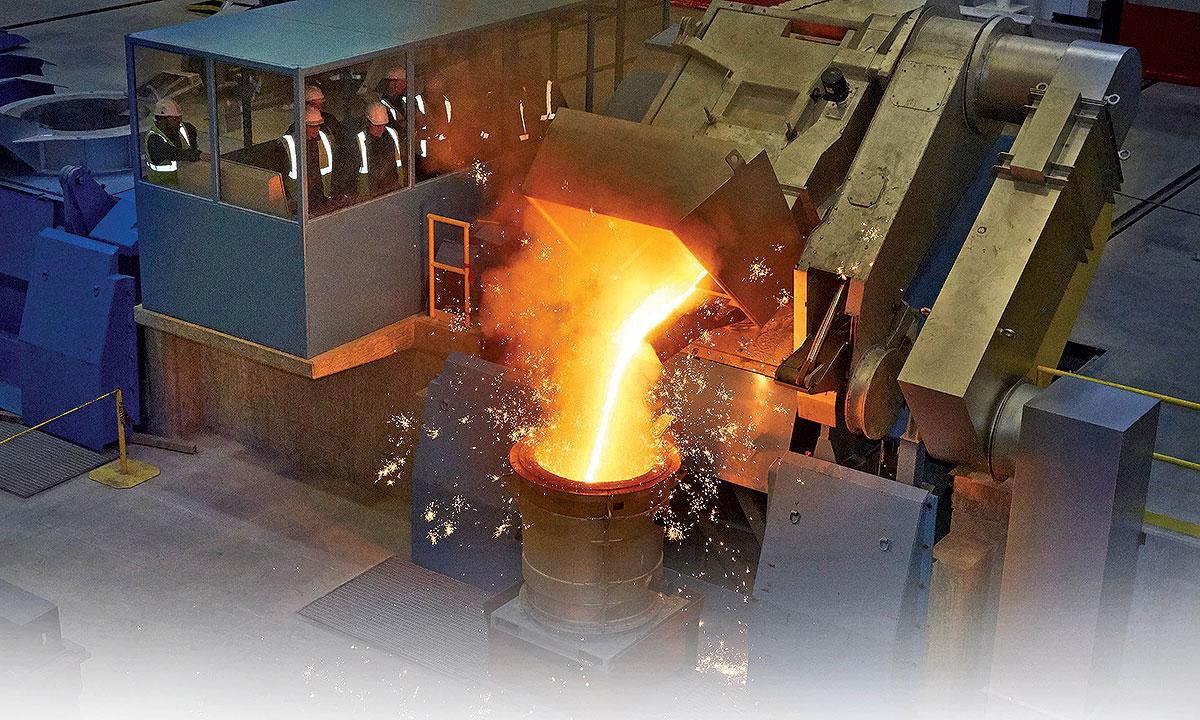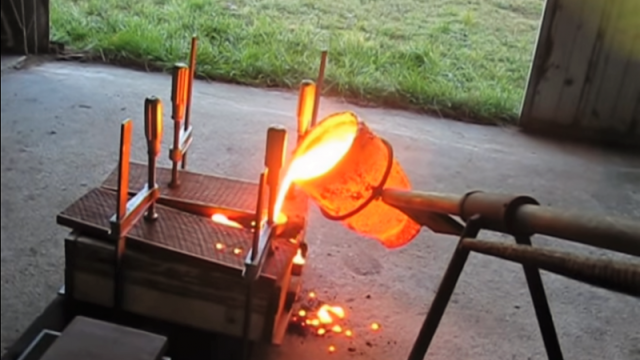Why Metal Casting Is Essential in Engineering Fields
Everything About Metal Casting: Exactly How Foundries Supply High Quality and Precision in Manufacturing
Metal casting stands as a fundamental process in production, where raw steels are changed into certain components. Foundries utilize various casting methods to achieve preferred features and forms. Each method comes with its very own collection of advantages and restrictions. Recognizing these nuances is crucial for appreciating how top quality and precision are maintained throughout the process. The conversation ahead will discover the intricate characteristics of metal casting and its significance across numerous sectors.
The Basics of Metal Casting
Metal casting is a fundamental process in producing that includes shaping liquified metal right into wanted kinds. This essential technique begins with the choice of raw products, typically numerous metal alloys, which are melted in a heater. When the metal reaches the proper temperature, it comes to be liquid and ready for casting.
The procedure calls for a mold, usually made from sand, metal, or ceramic, which specifies the final form of the actors things. Once the molten metal is put into the mold, it cools down and strengthens, handling the mold and mildew's shapes.
After cooling down, the casting is eliminated from the mold and mildew, and any type of essential ending up processes, such as brightening or cutting, are performed. This approach allows producers to produce complicated forms and elements with high precision and minimal waste. Metal casting is commonly made use of throughout different markets, from vehicle to aerospace, highlighting its significance in modern-day manufacturing.
Kinds Of Casting Techniques
While various casting approaches exist, each technique provides distinct benefits and is matched for different applications. Sand casting, one of one of the most usual approaches, makes use of sand as the mold and mildew product, permitting detailed styles and big components. Financial investment casting, understood for its precision, utilizes a wax pattern coated in ceramic, making it perfect for intricate geometries. Die casting, which involves compeling molten metal into mold and mildews under high pressure, is regularly utilized for mass production of small, thorough parts. In addition, covering molding incorporates sand and material to develop thinner, more exact molds, boosting surface coating. One more method, continual casting, enables the production of long sizes of metal shapes, streamlining manufacturing procedures. Each of these approaches plays a critical function in the metal casting industry, addressing certain needs from production quantity to design intricacy, consequently adding to the diversity of applications throughout numerous industries.
The Function of Foundries in Production
Foundries offer an important feature in the production landscape, as they transform raw metals right into functional elements through different casting processes. These centers use an array of methods to create items that satisfy specific specifications, therefore ensuring top quality and effectiveness in production (Aluminum Casting). By using techniques such as sand casting, investment casting, and pass away casting, factories deal with diverse sectors, consisting of vehicle, aerospace, and building and construction

Inevitably, foundries are integral to the production ecosystem, providing vital components that support a wide variety of applications and sectors. Their precision and adaptability drive effectiveness in modern manufacturing.
Products Utilized in Metal Casting
The option of materials made use of in metal casting is important for attaining the desired residential properties and performance of the end product. Different steels such as iron, bronze, and light weight aluminum are generally employed, each offering unique benefits. Aluminum is favored for its corrosion-resistant and light-weight high qualities, making it ideal for automobile and aerospace applications. Iron, specifically cast iron, is recognized for its exceptional fluidity and stamina, appropriate for hefty equipment and infrastructure components. Bronze, with its premium wear resistance, is frequently made use of in marine settings.
Furthermore, materials such as silica sand are often utilized for mold and mildew production, offering a great balance in between durability and convenience of shaping. The selection of products also consists of ingredients like fluxes, which boost the casting process by enhancing fluidity and minimizing oxidation. Eventually, the proper option of these products significantly influences the efficiency and high quality of the casting procedure.
Quality assurance in the Casting Process
Quality assurance in the casting process is important to guarantee that final items fulfill industry standards and specifications. Various inspection strategies are used to determine problems and examine the stability of cast components. Furthermore, adherence to developed criteria and qualifications enhances the integrity and performance of actors materials.
Inspection Techniques Employed
Keeping the integrity of actors metal parts relies heavily on numerous examination methods. Foundries employ aesthetic assessments as an initial procedure to determine surface issues, such as fractures or inclusions. Non-destructive screening (NDT) techniques, consisting of ultrasonic testing and radiographic inspection, are essential for identifying interior flaws without endangering the element's integrity. Dimensional examinations utilizing calipers and coordinate measuring equipments confirm that parts fulfill specified resistances. Additionally, chemical analysis validates that the alloy structure lines up with needed requirements. These examination strategies collectively confirm that the spreadings satisfy the required top quality and performance criteria, eventually decreasing the risk of failing in their designated applications. Applying these extensive assessments is basic for preserving high standards in metal casting production.
Standards and Certifications
Criteria and qualifications play an important duty in the quality control of the casting procedure. Foundries stick to various worldwide and industry-specific requirements, such as ISO 9001 and ASTM standards, assuring uniformity and reliability in their items. These criteria describe the necessary criteria for materials, production techniques, and testing procedures, adding to a much more reliable production procedure. Qualifications, such as AS9100 for aerospace applications, better highlight the relevance of top quality guarantee in specialized fields. By obtaining these qualifications, foundries show their commitment to excellence, improving and lowering problems consumer complete satisfaction. Routine audits and inspections confirm compliance, promoting continual improvement and technology within the sector. Inevitably, adherence to developed requirements cultivates trust between producers and clients.
Advancements in Casting Technology

3D Printing Integration
Incorporating 3D printing innovation right into metal casting processes is transforming the manufacturing landscape. This ingenious fusion improves the style and production of complex geometries that traditional techniques battle to achieve. By utilizing additive manufacturing for developing cores and mold and mildews, foundries can considerably minimize preparations and product waste. 3D printing permits for quick prototyping, enabling manufacturers to test designs quickly and efficiently, thereby promoting repetitive renovations. This modern technology likewise supports the production of lightweight parts, which are necessary in markets like aerospace and automotive. Consequently, the combination of 3D printing not only enhances procedures yet also elevates the precision and quality of actors metal products, noting a noteworthy development in the market.
Automated Manufacturing Processes
The developments in 3D printing have paved the means for more technologies in automated manufacturing processes within metal casting. Foundries are increasingly taking on robotics and automation to enhance performance and precision. Automated systems simplify the entire casting workflow, from mold and mildew development to putting and completing. Smart sensing units and real-time tracking enable accurate control of temperatures and product circulation, minimizing waste and enhancing quality. In addition, software program remedies help with far better style and simulation, enabling suppliers to enhance procedures before manufacturing begins. These automatic production procedures not just lower labor expenses but additionally reduce human error, making certain regular output. Consequently, the assimilation of innovative innovations in metal casting is revolutionizing manufacturing capabilities and fulfilling the growing needs of different sectors.
Advanced Product Development
As industries demand greater performance and sustainability, developments in product development for metal casting are arising as a crucial emphasis. Scientists and engineers are discovering new alloys and composites that improve mechanical properties while decreasing environmental influence. Technologies include lightweight products that keep strength, enabling much better fuel effectiveness in transport applications. In addition, the unification of recycled products is becoming extra common, straightening with sustainability objectives. Advanced casting techniques, such as 3D printing and precision molding, enable for the production of intricate geometries that traditional methods can not achieve. These developments not only improve the performance of actors elements however likewise enhance production effectiveness. In general, the constant evolution of product science drives the future of metal casting, meeting the needs of contemporary industries.
Applications of Metal Casting Throughout Industries
Metal casting plays an important function in various sectors, as it permits the production of complicated forms and high-grade parts with relative efficiency - Metal Casting. In the automobile sector, cast steels are crucial for producing engine blocks, transmission situations, and other vital parts that require longevity and precision. Aerospace markets utilize metal casting for parts like wind turbine blades and architectural aspects, where reliability is critical
In addition, machinery and tools production gain from metal casting by producing equipments, real estates, and various other elaborate components that enhance performance. The construction industry additionally employs metal casting for architectural functions, architectural supports, and installations, showcasing versatility.
The medical field counts on actors metals for medical instruments and implants, emphasizing the demand for biocompatibility. On the get more info whole, metal casting is a fundamental procedure across numerous fields, giving options that fulfill rigid quality standards and performance needs.
Often Asked Concerns
What Precaution Are Taken in Metal Casting Foundries?
In metal casting foundries, precaution consist of safety equipment, air flow systems, regular equipment upkeep, employee training, and emergency protocols to minimize risks related to heats, dangerous materials, and prospective mishaps during the casting process.
How Do Foundries Manage Waste and Environmental Impact?
Foundries handle waste and ecological effect through recycling products, carrying out filtration systems for emissions, and sticking to regulations - Metal Casting. They likewise embrace sustainable methods, such as minimizing energy usage and using environment-friendly substances in their processes
What Are the Expenses Related To Metal Casting Procedures?
The prices associated with metal casting processes consist of resources, labor, tools upkeep, power intake, and waste monitoring. Furthermore, changes in market costs and compliance with ecological policies can greatly influence total expenses for factories.
How Does Metal Casting Contrast to Other Production Techniques?
Metal casting provides distinctive advantages, such as intricate forms and high material effectiveness, compared to methods like machining or marking. However, it might involve much longer lead times and greater initial prices, depending upon task specs.
What Occupation Opportunities Exist in the Metal Casting Sector?
The metal casting industry supplies numerous profession opportunities, consisting of shop management, procedure engineering, high quality guarantee, mold and mildew layout, and machine operation. Specialists can also go after duties in research and growth, sales, and environmental wellness and safety.
Metal casting stands as a foundational procedure in production, where raw steels are transformed into certain elements. Metal casting is an essential procedure in manufacturing that includes forming liquified metal into wanted forms. Another approach, constant casting, makes it possible for the production of long sizes of metal shapes, streamlining manufacturing procedures. The prices associated with metal casting processes consist of raw products, labor, equipment upkeep, power usage, and waste administration. The metal casting sector provides numerous occupation opportunities, including shop monitoring, process engineering, top quality assurance, mold style, and equipment operation.